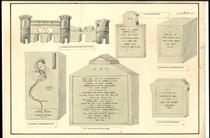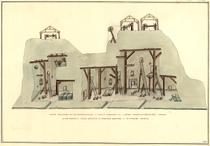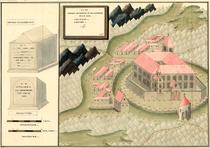Interest in history, especially of the ancient world,
was common in the intellectual circles of Early Modernism and Bernhard Paul Moll expressed this by collecting historical maps.
They were typically inscribed with Latin and Greek toponyms, often adorned with portraits of ancient rulers or illustrations of coins.
The fondness of the creator of this collection for classical studies is reflected in the section of curiosities,
where it clearly shows in his passion for epigraphic monuments. He had many of them redrawn for the Austrian Atlas and White catalogues,
where they were accompanied by comprehensive treatises written by
local experts (for example, the texts for Moravia were written by Josef Dismas von Hoffer).
Before consulting these collections, a few words on the origin and authorship of those drawings are necessary.
They were created through the initiative of Bernhard Moll himself and it is possible that he desired to fill the gap
in his collection in the area that was of his particular interest. Perhaps his scientific ambitions manifest themselves here.
According to the original manuscript catalogue the drawings should be a part of the otherwise unknown Handriss Archive of the
Emperor Francis Stephen of Lorraine. However, its existence is highly questionable.
It is possible that this reference was only used to cover the authors’ attempt to legitimise the fake drawings.
On the other hand, it is not yet possible to exclude the existence of the emperor's collection.
Similarly, the authorship of these drawings has not been satisfactorily explained either.
Signed specimens contain the name Geyer, who was known to have been an officer.
The attempt to identify Geyer with a specific person, has not yet been successful,
the varied quality of the drawings however suggests that there was most likely an entire workshop.
Besides the quality plans of urban fortification mainly from Hungary and partly an Italian environment,
the drawings signed with the name Geyer represent predominantly poor quality creations,
treated very schematically and as shown, largely spurious.
The drawings can be categorised into four thematic groups: fortifications, mines, chateau and castle buildings,
and ancient monuments, especially epigraphic ones.
The inclusion of dates allows for the dating of the collection between the years 1739-1756.

The Epigraphic pictures were partly revealed as fakes as early as the first half of the 19th century,
yet thanks to one of the copies of the Moll catalogue kept in Graz they remained a subject of professional discussions until the 20th century.
It is difficult to judge today whether the drawings were deliberate forgeries by the author,
or whether local nobles sought to create a reputation of authenticity around artificial Roman monuments on their estates,
that would deliver a hallmark of antiquity to their holdings, the reflection of which would fall upon them as well.
The artist than could only make copies. Most likely, they are fictional images processed according to written records by reporters,
sometimes perhaps supplemented by a diagram. It also seems that the authors sought to use the available maps to draw the surrounding landscape.

Bergwerke is a designation for similar images of mines and mining areas.
Bizarre spaces of mines full of naively depicted mining dwarfs (Permoník) can only conjure up an indulgent smile,
but hardly offer aesthetic experience to anyone save for a someone with extremely specific taste.
If the drawings carried any information at all, then most likely only about the actual or alleged occurrence of ore in a particular place.
Still, one cannot condemn these drawings as incomprehensible indulgences of an eccentric nobleman of the era of Marie Therese.
The interest in mining and ore mining continued throughout the 18th century, only the approach to the subject was transformed.
Much of the first half of the 18th century consisted in more of a Baroque perception of minerals which mixed the early scientific concept of chemistry,
mineralogy, and economics with alchemy and the occult.
A rational approach was not yet as distinguished from irrational as during the Enlightenment,
and certainly not sharply separated. This was an outcome of 19th century science.
Ever since the 17th century precious metals were the focus of both economic and political theorists.
It was a response to signs of hitherto unknown inflation, negative economic balance or governmental debt.
Most of the first economists focused their attention not only on the question of the improvement of coins or the extraction of metals,
but they also tried to get these natural substances through alchemy which was then considered to be a relevant scientific field.
Delight in these sciences was mainly a privilege of members of the social elite. For the most part they belonged to one of two groups,
from which scientists and occultists in one person were recruited - officials, usually fresh nobility and the high aristocracy,
rulers were not an exception.
In the 18th century these previously isolated intellectuals began to form a variety of associations of like-minded individuals,
learned societies were established, the Masonic Lodge, the Society for the Advancement of Agriculture and Art.
The society of the Enlightenment began to form. Science,
strictly separated from the rest of the world as we know from the 19th and 1st half of the 20th century, had not yet developed.
Elite clubs of nobles and intellectuals represented a platform for debate, which refined opinions handed down for generations,
forced argumentation became the breeding ground of science.
The desire to learn about mineral deposits indicates Bernhard Paul Moll's intellectual orientation,
having himself ordered these images, it also reveals the fact that he belonged to elite circles.
From this point of view the seemingly naive drawings regain their forgotten sense.





